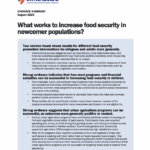The Supplemental Nutrition Assistance Program (SNAP) is a highly effective program, vital to our nation’s health and well-being. SNAP’s entitlement funding structure allows it to provide benefits to anyone who meets the program’s eligibility requirements, and this structure also enables SNAP to respond quickly when need increases. Research shows that SNAP reduces poverty for millions, improves food security, and is linked with improved health. Despite SNAP’s successes, there is room to build on its considerable accomplishments. Evidence suggests that current benefit levels are not adequate for many households. Some vulnerable groups have limited SNAP eligibility, and some eligible individuals face barriers to SNAP participation. Policymakers should address these shortcomings by increasing SNAP benefits and expanding SNAP eligibility to underserved groups. The federal government and states should also continue improving policies and procedures to improve access for eligible individuals.
A Systematic Review on the Impact of Trauma-Informed Education Programs on Academic and Academic-Related Functioning for Students Who Have Experienced Childhood Adversity
The purpose of this study was to conduct a systematic review of the existing literature regarding trauma-informed education programs and their impact on academic and academic-related outcomes. The articles included for review (n=15) contained data on trauma-informed education programs implemented in preschool, primary/elementary, and high school settings. Academic and academic-related outcomes reported included attendance, disciplinary…

